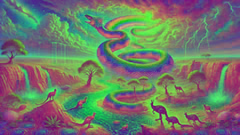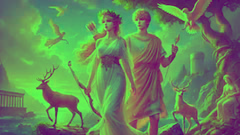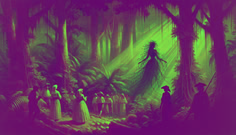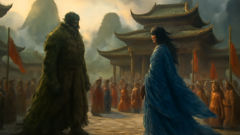Introduction
Long before recorded dynasties and the inked brushstrokes of court history, a story of sky and stone was already being told beside hearths and rivers. It begins in a time that feels like the first breath of the world, when the distinction between gods and the earth itself was not yet fully drawn. The heavens were a luminous canopy, the earth a firm and yielding bed; creatures multiplied and rivers braided the land into patterns that storytellers would later call landscapes. In that age of formative wonder, humans lived small and fragile beneath the vault of day and night. They were mortal, curious, and often helpless before the sweeps of wind and the caprices of flood. Into this fragile world stepped Nüwa, a creator whose compassion and craft would reshape how people perceived origins. She was not only maker but mender, a being of clay and breath whose hands could form life and whose wisdom could read the silence between stars. This is the tale of how the sky once cracked, how the pillar that held heaven rooted in earth was shattered, and how Nüwa gathered five-colored stones and called upon a turtle's strength to stitch the world back together. It is a story about necessity and kindness, about the cost of catastrophe and the patient ritual of repair. As you read, imagine stone warmed by sunlight, molten color glowing like trapped rainbows, a vast turtle's slow exhalation beneath an upturned cosmos. This retelling seeks to honor the myth's original voice while exploring its symbolism and cultural echoes, carrying the smell of incense, the hush of mountain wind, and the vivid shimmer of those five sacred colors.
The Tale Retold: Nüwa, the Five-Colored Stones, and the Shattered Pillar
The oldest versions of this myth are spare: a sky falls, people suffer, and Nüwa repairs the break. But the spare truth blossoms into a thousand images when retold across river plains, mountain hamlets, and the scroll workshops of later centuries. Start with the rupture. In many tellings, the cosmic catastrophe is not random misfortune but the aftermath of a contest between elemental forces—wind, water, thunder—loosed by jealous gods or a jealous dragon. One moment stillness holds the world; the next a spray of molten rock and a thunderous hammering of elements rends the pillar of the sky. Imagine the pillar as a linkage of principles: a column of order connecting the heavens' regulated cycles to the earth's steady growth. When it collapses, the sky tilts, rivers rise, and the fidelity of seasons wavers. Birds lose their bearings; mountains, no longer anchored in mythic faith, seem to slide toward the horizon. Fires ignite from broken celestial lamps, and chasms open where people once walked.

Nüwa watches this chaos with a maker's mind. She is sometimes described as fashioned from yellow clay, molded and warmed by the sun. In other accounts she is part serpentine—an image that binds her to the river's twisting motion and to the underground channels of life. Her compassion is the myth’s heart: where gods might punish, she repairs. Nüwa surveys the sky as a weaver might assess a torn tapestry. She does not curse the heavens; she listens. She collects from the earth that which is most alive: five stones of iridescent hue. They are not ordinary rocks. The colors—red, yellow, blue, black, and white—carry symbolic weight. Red for vitality and the heart’s ember, yellow for the yielding fertility of earth and grain, blue for the depth of water and the mind's serene vastness, black for the mystery of night and the grounding of roots, white for clarity and the sharing of light. Some variations call them gemstones, others call them earthen pigments smelted in fire; all agree they shine with a color that feels like weather compressed into mineral.
To repair the heavens, Nüwa melts these five colors into a new seam for the sky. The melting is itself a ceremony. She gathers fire and river water, mixes clay and ash, and sings names of the winds while kneading the colors so they bleed into one another like dawn and dusk. As she applies the molten hues to the sky's wound, she hums a rhythm that becomes the heartbeat of the world: measured, patient, insistently kind. But color alone cannot hold up a cosmos. The myth introduces an enormous turtle—sometimes called Ao or the great tortoise—whose legs become new pillars to rest the heavens upon. This turtle is ancient and slow as geology; its legs are like mountain trunks. Nüwa coaxes it, and the creature obliges, bending its limbs beneath the sky’s repaired seam. There is an exchange between creature and creator; the turtle becomes altar and axle, and the colors become sutures. The scene is intimate, even domestic: fingers pressing molten color into a seam, breath fogging the edges, a great turtle's groan like a distant thunderclap.
This repair ushers in a new order. The sky may never be what it was—a little lower, a little more luminous in places patched by Nüwa’s hues—but it is whole. The repair becomes a memory woven into the landscape: stones in certain riverbeds are said to still glow faintly under moonlight; turtles are honored at particular shrines; festivals appear at harvest time where people paint five colors on banners and garments. The myth thus creates etiquette for humility: the world can be mended, but only with labor, with apology to the elements, and with a willingness to act. The figure of Nüwa teaches that salvation is a work of craft and care, not of simple imposition. She does not hurl thunder or demand sacrifices for immortality; she kneads and molds, chooses materials, and enlists help. That is why the five colors are more than pigment—they are a philosophy: to restore wholeness one must bring together diverse strengths. The legend suggests a moral geometry where different hues become mutual supports: when red leans into blue, when black steadies white, the composite seam becomes strong.
Beyond the mechanics, the myth contains genealogies. Nüwa is often credited with forming mankind from yellow clay, shaping figures with her hands, and breathing into them the spark that sets thought awake. Some ancient lines say that after she repaired the sky, she became the patron of craftspeople—potters, weavers, and builders—those who know how to mend what is broken. Temples carved along river gorges celebrate her with statues and offering tables. The five-colored stones themselves are recurrent motifs in bronze mirrors, painted screens, and embroidered robes, serving as visual shorthand for cosmic balance. Over centuries, poets and painters return to the image of Nüwa sitting by a seam of sky, a bowl of glowing stone at her elbow, as children gather to watch the last shavings of light fall like petals into the river. The tale remains both accessible and oddly technical: practical—how to assemble materials, how to coax a turtle—and metaphysical—what it means for humans to live under a sky that required mending.
Read through the myth's layers and you find it multilayered: an explanation for natural disasters, a charter for social responsibility, a mythic taxonomy for color and material, and a template for creative labor. Most of all, it emphasizes the intimacy between creature and cosmos. The world is not a stage of immutable rules; it is a fabric that requires attentive hands. Nüwa’s act is a model: repair may be awkward and messy, but it is the only authentic response to loss. That idea—repair as moral action—resonates across the ages, informing rituals, inspiring artworks, and echoing in the pragmatic philosophies of local communities that have told this story for generations.
Echoes and Afterlife: Rituals, Art, and the Cultural Legacy of a Sky Repaired
The myth of Nüwa mending the heavens did not remain a single tale in one province; it radiated outward and layered itself over local practices and cosmologies. Across river basins and mountain valleys, people adapted the central images—the shattered pillar, the five-colored stones, the turtle's support—into ceremonies that fit agricultural calendars and familial rites. In one farming community, elders recall a spring practice of painting five small tablets in the colors of the myth and sinking them beneath the first irrigation channel, an offering meant to keep the water's temperate flow steady. Elsewhere, fishermen tie five-colored ribbons to bamboo poles before launching into uncertain seas, echoing Nüwa’s ritual of color as a plea and as a promise. The myth becomes a living grammar for public life: where to plant a temple, how to mark a boundary, what to chant when floods threaten. It offers a vocabulary for repair that is both symbolic and tactile.
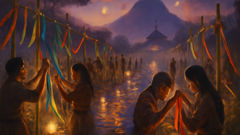
Artists have long been captivated by the visual drama of Nüwa’s labor. Court painters in later dynasties rendered the scene as a sweeping mural: a goddess bent beneath a luminous fissure, a turtle the size of a pagoda rising from the mist, molten colors streaming like rivers that shift hue in the space of a single brushstroke. In those paintings, the five colors are rarely flat; they shimmer, overlap, and seem to pulse with inner light. Sculptors interpret the story differently: bronze figurines show Nüwa with tools at her side—chisel, basket, and a small furnace—transforming the myth from a single, unrepeatable miracle into a craft practice anyone might learn. The narrative thereby sanctifies workmanship. It gives ritual respect to those who shape the world with their hands, from bricklayers to seamstresses.
The myth also became a fertile source for philosophical reflection. Neo-Confucian and Daoist thinkers invoked the story not merely as an etiology for natural events but as a moral allegory. Some moralists emphasize Nüwa's compassion as an ethical standard: rulers should mend the ruptures in society—corruption, famine, unjust law—rather than punish the populace. Daoists read the five colors as markers of balance and transformation, reminders that the interplay of elements creates a stable pattern. Poetry anthologies across centuries contain quatrains that turn the image of Nüwa into a metaphor for artistic restoration: the poet who repairs a line of verse, the calligrapher who corrects a stroke, the musician who restores harmony to a dissonant passage. These uses show how a myth becomes a cognitive tool, shaping how societies approach brokenness.
Local customs sometimes preserve elements of the original story with surprising fidelity. In one coastal shrine the turtle is still venerated; fishermen leave offerings of seaweed and rice to the turtle's image before long voyages. In another mountain village, elders recount a tall tale that after Nüwa mended the sky she taught villagers how to build levees and terraces, implying a direct chain from myth to practical knowledge. Such claims are not historical proof but cultural testimony: myths inform practice, and practice keeps myths alive. They are living threads between cosmology and everyday survival.
Modern reinterpretations continue to find new relevance. Contemporary writers, filmmakers, and visual artists revisit the story with fresh concerns—gender, ecology, and disaster recovery. Nüwa's role as both creator and mender resonates strongly in an era of climate disruption: she models a way of responding to catastrophe that foregrounds repair and communal effort over blame and fatalism. Eco-critics and activists sometimes borrow the mythic language of mending, advocating policies framed as 'mending the commons' or 'repairing habitat'—phrases that directly echo the symbolic economy of Nüwa's story. In classrooms, educators use the myth to teach children about resilience, practical problem-solving, and the interdependence of humans and natural systems. Museums mount exhibits where a painted panel of Nüwa sits beside modern images of community-led flood defense, inviting audiences to draw implicit links across time.
The imagery also survives in domestic arts: five-color embroidery patterns are used on festival garments and wedding robes, where each color connotes a wish for safety, fertility, clarity, strength, and prosperity. Such use shows how cosmological narratives find their way into the smallest human interactions. When a family ties a five-color knot on a newborn's crib, they are performing a miniature invocation of cosmic repair—they are placing their child beneath a sky that was once fragile and is now intentionally held together by ancestral care. This domestic echo is one of the myth's most enduring gifts: it transforms a distant divine labor into a daily, human-scale practice. Across centuries, the myth of Nüwa mending the heavens has proved endlessly adaptive because at its core it speaks to a universal human condition: we live in a world that sometimes breaks, and what saves us is not a single godly gesture but the repeated, patient work of menders—people and creatures and, crucially, the practice of joining disparate elements into a coherent whole.
Conclusion
The story of Nüwa mending the heavens endures because it speaks to the human impulse to repair: to respond to damage with labor, creativity, and compassion rather than with despair. Whether the broken pillar is a meteor-shattered sky, a river-warped dyke, or a fractured community, the myth offers a template—gather materials, recruit aid, proceed patiently, honor the powers that grieve and the creatures that help. The five-colored stones are symbols but also prescriptions: assemble diverse strengths, melt them together with care, and press the seam until it holds. The turtle is not merely a participant; it is a reminder that restoration often needs patient, foundational support. Across art and ritual, poetry and policy, the figure of Nüwa has been invoked to give dignity to work that is often unseen: mending, tending, creating continuity after calamity. Modern readers and listeners can take from the tale a practical ethic: when we face damage—ecological, social, or personal—the best answer may be slow, material, and communal. The goddess who shaped mankind from clay and stitched the sky with color offers a radical kindness: that the cosmos is not a machine sealed against error but a fabric that can be lovingly repaired. By keeping Nüwa's story alive—through festivals, murals, schoolbooks, and quiet rituals—we do more than remember an origin; we practice the old, necessary art of mending.



